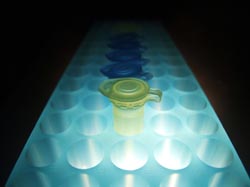Protocols for cryo-conservation of plant germplasm
The main objective of the CRYMCEPT project was to develop new cryo-conservation protocols for the long-term storage of plant germplasm. The critical point of injury for cryo-conservation protocols was identified by assessing the extent of modifications and or loss of proteins associated with the cytoskeleton and signalling pathways. Results included the development of transglutaminase assays and the identification of markers of desiccation and freezing tolerance for profiling cryo-injury. The findings can be used to design and improve new cryo-conservation protocols for a wide range of plant species. It is vital for a successful outcome to use storage methods based on an informed knowledge of cryo-injury, rather than empirical know-how. The identification of critical points through the use of markers of protein modification/loss has resulted in improved storage efficiency. This has helped minimise the amount of germplasm lost from cell injury and increased confidence in cryo-storage. Innovative benefits have included bespoke techniques for application by end users, such as germplasm repositories and collections, botanic gardens and biotechnology companies. The main strength of these results is the integration of technological and fundamental approaches to provide markers of cell injury. These contribute to the design of less damaging cryo-storage protocols, particularly for storage recalcitrant germplasm.




